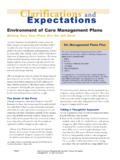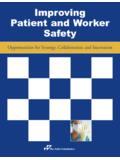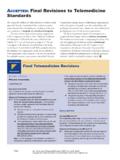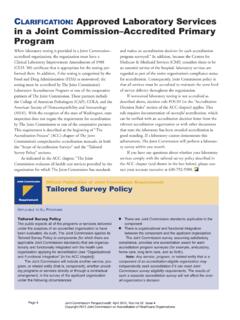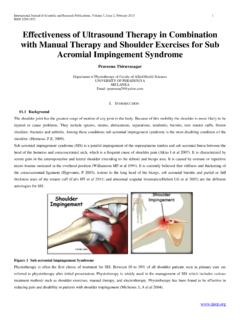Transcription of CLABSI Toolkit Tool 2-4 CLABSI Reduction Initiatives and ...
1 CLABSI Reduction Initiatives and CampaignsContinued on next pageScope/Developed by/ Citation or Web AddressTime Frame(may include links to Descriptionpublications or tools) initiative : Canadian Patient Safety Institute (CPSI) - Safer Healthcare Now! initiative : Hospital Israelita Program to Prevent CLABSIs S o Paulo, BrazilScope of the initiative :National (Canada)Developed by:Canadian PatientSafety InstituteTime frame: initiative designed witha 5-year implementa-tion periodCanadian Patient SafetyInstitute. Safer HealthcareNow! Accessed Mar 18,2012. Patient SafetyInstitute. Safer HealthcareNow! CentralLine AssociatedBloodstream Infection( CLABSI ). Accessed Mar18, 2012. : Healthcare Now!
2 Is a national campaign that supports Canadianhealth care organizations in their patient safety improvement efforts,including those directed at preventing focus of the cam-paign is reducing avoidable harm by implementing evidence-based inter-ventions. The campaign is supported by IHI and is patterned after IHI s 5 Million Lives campaign . CPSI has issued an open invitation to allCanadian hospitals to participate in one or more of the nine SaferHealthcare Now! interventions, such as rapid response teams, ventilatorassociated pneumonia (VAP), or CLABSI . Each intervention includesresources and tools that are customizable, reliable, tested, and basedon 5 years of improving care and designed to provide everything neededto implement, measure, and evaluate the patient safety of rates is voluntary, and hospitals that report data areincluded in aggregated reports that are publicly CLABSI intervention has tools for both insertion and maintenance ofCVCs, and it encourages organizations to measure their CLABSI ratesover how-to guide includes such topic areas as the impor-tance of using a multidisciplinary team approach, using data to defineand monitor CLABSIs, setting time-specific and measurable goals, edu-cating staff.
3 And using techniques for overcoming barriers. Scope of the initiative :Single organization38-bed medical/surgi-cal ICU and two 20-bed step-down units(SDUs)Developed by: HospitalIsraelita, S o Paulo,BrazilTime frame: March2005 March 2007(baseline period)April 2007 April 2009(intervention period)Marra AR, Cal RG, Dur oMS, Correa L, GuastelliLR, Moura DF Jr, EdmondMB, Pavao Dos SantosOS. Impact of a programto prevent centralline associated blood-stream infection in thezero tolerance era. Am JInfect Control. 2010 Aug;38(6):434 full barrier precautions at insertion, 2% chlorhexidine skin prepa-ration prior to catheter insertion, and periodic feedback on adherence torecommended practices were in place in the baseline period (phase 1),the hospital s chief executive officer announced a zero tolerance forCLABSI initiative in April 2007 (phase 2).
4 IHI s central line bundle wasimplemented in the ICU and the two SDUs, which included creation of acentral line cart, emphasis on hand hygiene, optimal catheter site selec-tion (avoiding femoral vein), and daily review of line necessity. Feedbackwas provided on adherence to the bundle as well as CLABSI rates CLABSI rate per 1,000 catheter-days in the ICU in phase 1 , and in phase 2 it had decreased to ; the rate in the SDUsdecreased from to per 1,000 study suggests that the same prevention principles and evidence-based practices that decrease CLABSIs in the ICU can be applied to thenon-ICU setting as well. The Joint Commission. May be adapted for internal use. Suggested citation: The Joint Commission.
5 Preventing Central Line Associated Bloodstream Infections: Useful Tools, An International Perspective. Nov 20, 2013. Accessed [user please fill in access date]. Reduction Initiatives and Campaigns (continued)Scope/Developed by/ Citation or Web AddressTime Frame(may include links to Descriptionpublications or tools)Continued on next pageCampaign: Institute for Healthcare Improvement (IHI) 5 Million Lives CampaignIHI s 5 Million Lives campaign (formerly the 100,000 Lives campaign )was a voluntary initiative to protect patients from 5 million incidents ofmedical December 2006 and December 2008, IHI chal-lenged US hospitals to adopt any or all of 12 interventions that savelives and reduce patient injuries, including CLABSIs.
6 Each of the inter-ventions had multiple resources available to support hospitals thatundertook interventions, such as how-to guides, PowerPoint presenta-tions with facilitator notes, access to mentor hospitals that providedsupport and tips to hospitals seeking help with implementation efforts,and various improvement tools submitted by participating process and outcome measure information was also a national harms avoided number was not announced at theconclusion of the campaign , IHI is studying the progress of campaignhospitals in reducing mortality and harm in other ways and is also work-ing with other national organizations to tap into existing databases tomeasure changes in specific types of harm (for example, medicationerror, infection, surgical complication).
7 IHI also has begun to collect information on hospitals getting to zero reducing adverse event rates to zero for extended periods of time inseveral appropriate intervention areas. For example, Rhode Island hos-pitals that were active in the campaign reported a 74% decrease inCLABSIs from 2006 to 2008, and several hospitals reported going ayear or more without a CLABSI in at least one of their of the initiative :National (US)Developed by:Institute for HealthcareImprovement (IHI)Time frame: December2006 December 2008 Institute for HealthcareImprovement. 5 MillionLives campaign . AccessedMar 18, VA, McNicoll L,Cornell M, Rocha JM,Adams L, Pronovost Rhode Island ICU col-laborative: A model forreducing central line associated bloodstreaminfection and ventilator-associated pneumoniastatewide.
8 Qual Saf HealthCare. 2010 Dec;19(6):555 for HealthcareImprovement. PreventCentral Line Mar 18, : : CLABSI bundle andchecklist developed byPeter Pronovost: How to Guide:\\Jcfs2\data$\DRE\THECENTER\Projec tsFunded\Baxter\Phase2\ Toolkit development\In Process\ The Joint Commission. May be adapted for internal use. Suggested citation: The Joint Commission. Preventing Central Line Associated Bloodstream Infections: Useful Tools, An International Perspective. Nov 20, 2013. Accessed [user please fill in access date]. on next pageCLABSI Reduction Initiatives and Campaigns (continued)Scope/Developed by/ Citation or Web AddressTime Frame(may include links to Descriptionpublications or tools)Continued on next pageInitiative: International Nosocomial Infection Control Consortium (INICC) Strategy on CLABSI Founded in 2002, the International Nosocomial Infection Control Con -sortium (INICC) is an international nonprofit, multicenter, collaborativeHAI infection control program with a surveillance system based on theNational Healthcare Safety Network (NHSN) of the US Centers forDisease Control and Prevention (CDC).
9 There are now more than 300intensive care units (ICUs) in approximately 40 countries on 4 continentsthat participate in the INICC (see ).At the conclusion of the INICC s first 8 years, the organization con-ducted a time-sequence analysis of CLABSI rates and associateddeaths in 86 ICUs in 15 developing countries; each ICU included in theanalysis had been a member of the consortium for a minimum of 6months and had submitted monthly surveillance data through December2008. Infection prevention and control practices (for example, handhygiene, use of maximal sterile barriers at catheter insertion, chlorhexi-dine skin antisepsis) were assessed via periodic surveys, and trends inprocess surveillance for hand hygiene and vascular care, as reportedmonthly, were analyzed.
10 The 3-month baseline period was compared tothe 24-month intervention Overall CLABSI rate in the 86 ICUs: Baseline: per 1,000 central line days 6 months into intervention period: per 1,000 centralline days 12 months into intervention period: per 1,000 centralline days 18 months into intervention period: per 1,000 centralline days All-cause deaths in patients with CLABSIs decreased by 58% bymonth 24. Adherence to hand hygiene improved from 50% at baseline to60% in the intervention period. Use of maximal sterile barriers at catheter insertion improvedfrom 46% at baseline to 85% by month 24. Limiting the duration of central line use improved from days , the researchers were able to demonstrate significant improve-ments in CLABSI rates and process indicators with a simple surveil-lance and performance feedback program.


